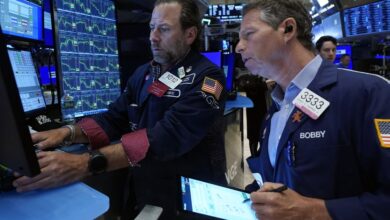The Stock Market Has Been on a Hot Streak. Why Not Everyone Thinks It Can Last.

It’s been another banner week for stocks, though not all strategists see an easy path to more gains.
On Wednesday, the
and
all notched record closes. The next day, the Dow breached the 40,000 mark for the first time during intraday trading. But for all the market’s momentum lately, the three major indexes couldn’t hold on to their gains Thursday, and ended in the red.
That might have been a bit of a disappointment for investors: When the Dow crossed both the 20,000 and 30,000 levels for the first times in 2017 and 2020, respectively, it stayed there.
While it’s never sensible to read too deeply into one day’s price action, some skeptics warn that investors shouldn’t get too complacent with the market’s latest hot streak. In fact, some indicators suggest the stock market could recede further before resuming any upward climb.
Piper Sandler’s Craig Johnson notes that more stocks were declining than advancing on Thursday, with both growth and value plays faltering. The breadth of the market gains—how widely dispersed gains are across stocks—remains a concern for him.
Advertisement – Scroll to Continue
“While the equity markets show a renewed sense of optimism, with the popular market averages trading back at year-to-date highs, more time and evidence is needed for our breadth indicators to sustain the rally off the April lows,” writes Johnson. “Until that occurs, we suspect…that another 5% pullback from current levels is more likely before another 5% advance.”
Johnson’s year-end S&P 500 target of 5,050 reflects that expectation, and he isn’t the only voice warning about a potential pullback. Stifel’s Barry Bannister says the S&P 500 could be in for a decline of 9% before the end of the year.
Likewise earlier this week, J.P. Morgan Global Markets Strategy head Marko Kolanovic reiterated that it’s too early for the market to price in a so-called soft landing, in which the economy would see inflation cool without heading into a recession.
Advertisement – Scroll to Continue
“The macro outlook is uncertain and for equities we are entering into a seasonally tricky time of the year, with a challenging combination of inflation at risk of staying too high, profit margin pressures, and elevated positioning,” he says.
It’s easy to understand why some strategists are wary of at least a pause in the rally, if not greater declines. While more companies in the S&P 500 are expected to see greater earnings growth by the end of the year, in other ways the winner’s circle has been narrowing. The Magnificent Seven big tech stocks have decoupled, as
is still trailing the broader market year to date, and
is deep in the red.
Nor is tech as a whole a slam dunk, as evidenced by the performance of the
Technology Select Sector SPDR Fund,
which was edging lower again on Friday despite gains for the Nasdaq and other major indexes. Other winning sectors have also struggled lately.
Advertisement – Scroll to Continue
Of course, there were other factors at play that could explain the Dow’s failure to stay above 40,000 on Thursday. Bond yields—a traditional headwind for stocks—were on the rise again, as was the U.S. dollar.
“The negative correlation of both bond yields and the greenback to equities has gradually increased in the last several weeks and thus has had a significant impact on price activity,” writes Johnson.
Within equities there wasn’t much support for market gains either. Ten of the 11 sectors closed lower Thursday. The Consumer Staples Select Sector SDPR exchange-traded fund was the lone winning sector Thursday, but even then, its 1.5% gain was largely driven by Walmart’s post-earnings surge. By contrast, the Consumer Discretionary Select Sector SPDR Fund, Materials Select Sector SPDR Fund, and Industrial Select Sector SPDR Fund got hit the most, lagging behind the broader market with losses of more than 0.6%.
Advertisement – Scroll to Continue
In addition, the Dow’s fallback Thursday isn’t unprecedented: In March 1999, the index had to hit the 10,000 mark seven times during intraday trading before finally closing above that level.
And it’s worth remembering that with a relatively resilient economy, slowing inflation, and earnings growth, bulls have had the upper hand for much of 2024. Even with Thursday’s slip, the market has made up for April’s losses and then some. The S&P closed just 0.2% below its Wednesday record of 5,308.15.
Stocks are climbing on Friday, and there are plenty of arguments in favor of the rally’s ongoing momentum. Still, with all three indexes bumping up against fresh highs, it’s prudent to remember that with stocks, it’s never a straight climb to the top.
Write to Teresa Rivas at teresa.rivas@barrons.com





